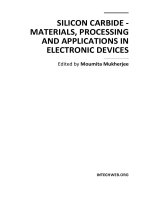Silicon Carbide Materials Processing and Applications in Electronic Devices Part 11 doc
Bạn đang xem bản rút gọn của tài liệu. Xem và tải ngay bản đầy đủ của tài liệu tại đây (3.88 MB, 35 trang )
SiC Devices on Different Polytypes: Prospects and Challenges
339
inherent in the build–up of the avalanche current, coupled with the phase delay developed
as the carriers traverse the depletion layer. The word IMPATT stands for “impact ionization
avalanche transit time”. IMPATT diodes employ impact–ionization and transit–time
properties of semiconductor structures to produce negative resistance at microwaves and
millimeter waves frequencies. The negative resistance arises from two delays which cause
the current to lag behind the voltage. One is the ‘avalanche delay’ caused by finite buildup
time of the avalanche current; the other is the ‘transit–time delay’ caused by the finite time
required by the carriers to cross the “drift” region. When these two delays add up to half–
cycle time, the diode electronic resistance is negative at the corresponding frequency.
IMPATT devices have emerged as most powerful solid-state devices for generation of high
CW and pulsed power at millimeter wave frequencies. These devices also provide high
oscillator output power with high DC to RF conversion efficiency in Silicon Monolithic
Millimeter Wave Integrated Circuits (SIMMWIC).
In a practical mm-wave IMPATT oscillator the diode is embedded in a circuit which is
resonant at a frequency within the negative–resistance band of the device. The oscillation is
initiated by random noise fluctuations, which grows in a negative–resistance medium at the
resonant frequency of the circuit. In practice the device has to be mounted either in a coaxial
line or in a section of wave-guide or in a micro strip circuit.
In 1954, Schokley first studied the microwave negative resistance from the transit time delay
of an electron bunch in a forward biased p-n junction diode. Afterwards, in 1958, W. T.
Read showed that the finite delay between an applied RF voltage and the external current is
due to the generation of carriers in a reverse biased p+-n i n+ diode under avalanche
breakdown and the subsequent drift of carriers through the depletion layer. This would
lead to a negative resistance of the device at microwave frequencies. In 1965, Johnston et al
experimentally observed microwave oscillation from a simple p+nn+ device. At the same
time Lee et al also reported oscillation at microwave frequency from a Read diode. Small
signal analysis of avalanche diodes of general doping profiles was carried out by T. Misawa,
who showed that the negative resistance occurs in any reverse biased p-n junction diode of
arbitrary doping profile.
In 1968 Lee et al first reported resonant-cap mounted IMPATT oscillator together with a
simplified equivalent circuit. Their report showed CW power of 100 mW at 50 GHz with
an overall efficiency of 2 percent. In the same year Misawa [9] reported millimeter-wave
oscillation from silicon avalanche diode with abrupt junction mounted in a resonant-cap
waveguide circuit. His report shows a CW output power in the range of 23 to 150 mW for
the 50 to 84 GHz frequency range with a maximum efficiency of 3 percent. In 1970,
Misawa and Kenyon reported mechanical tuning characteristics of resonant-cap IMPATT
oscillators at millimeter-wave frequencies. Since then , fast advances in semiconductor
technology , rapid advances have been made towards further development of various
IMPATT diode structures as well as IMPATT based oscillators and amplifiers to meet the
to-days high power requirement in higher frequency band. In recent years lot of interest
has been created regarding IMPATT diodes and oscillators based on SiC as a
semiconducting material. Considerable advancement regarding device physics, device
fabrication and the optimum circuit design for IMPATT oscillator and amplifiers has push
the frequency range to mm and sub mm regions which has resulted in the emergence of
IMPATTs the most powerful solid state devices for generation of microwave and mm
wave power.
Silicon Carbide – Materials, Processing and Applications in Electronic Devices
340
To understand the operation and performance of IMPATT devices and oscillators
knowledge of the basic IMPATT phenomena is required and briefly discussed in the
following section. To build an IMPATT oscillator the device has to be mounted in a suitable
microwave/mm-wave circuits. The performance of the oscillator strongly depends not only
on the device but also on the circuit in which the device is embedded .The various
microwave/mm-wave circuits that are being widely used to construct IMPATT oscillators
have been reviewed briefly.
A brief review of the fundamental physical processes involved in IMPATT action followed
by a review of the various IMPATT structures and oscillators will be presented in this
section. The factors, which determine the avalanche delay and the transit time delay for high
frequency operation of IMPATT will also be briefly discussed.
2.1 High field properties of charge carriers in IMPATT devices
The different scattering interactions between the charge carriers and the lattice lead to the
emission of both acoustic and optical phonons which give rise to the saturation of carrier’s
drift velocity in semiconductors which is one of the fundamental physical phenomenon
involved in IMPATT action.
Drift velocity of charge carriers has been observed to be linear upto the electric field 104
V.m-1 and it reaches a scattering limited value independent of the electric field when the
field is very high (>10
6
V.m
-1
). At low values of electric field (E), which the principal
scattering phenomenon is acoustic phonon, the drift velocity (v
d
) of charge carriers in
semiconductor varies as :
do
vE
μ
=
(1)
Where
o
μ
is the low field mobility and can be expressed as,
2
2
*
o
o
qv
mv
τ
μ
<>
=
<>
(2)
Where q is the charge of the electron, m* is the effective mass of the carrier,
o
τ
is the
relaxation time and v is the carrier velocity. The brackets in the above expression indicate
Maxwellian average.
In the low field region (Ohmic region), the rate of energy through acoustic phonon collision
is small and the scattering is isotropic. Assuming energy distribution to be Maxwellian at
lattice temperature T and a constant mean free path, the low field mobility is given by,
0.5
4
3(2 * )
a
o
ql
mKT
μ
π
=
(3)
Where la is the mean free path for acoustic phonon collision and K is the Boltzman constant.
At high electric field ( >10
6
V.m
-1
) high-energy electrons ( hot electrons ) interact more
strongly with lattice and there is a departure from the linear dependence of drift velocity
with the electric field. The thermal equilibrium is lost because the rate of energy gained
from the field is more that the amount lost to the crystal lattice through low energy acoustic
phonon collision. At this high field, emission of optical phonons is a dominant
phenomenon, which are quanta of high frequency thermal vibrations of the lattice in which
SiC Devices on Different Polytypes: Prospects and Challenges
341
two face centered cubic sub lattices of the crystal vibrate in the opposite directions.
Excitation of the optical phonons are possible when the electrons gain a minimum energy
equal to optical phonon energy or Ramam energy
()
2
o
p
o
h
εω
π
=
, where
o
ω
is the angular
frequency for optical mode of vibration and h is the Planck’s constant. The values of
o
p
ε
for
GaAs and Silicon are obtained from neutron scattering experiments [18-21] and are of the
order of 0.035 eV and 0.063 eV respectively. At a high field ( >107 V.m-1 ), the average
carrier kinetic energy exceeds the optical phonon energy
o
p
ε
and thereby a transfer of
energy to the lattice via optical phonon is created and reaches a scattering limited
average drift velocity independent of the electric field and is given by,
0.5
8tanh(2)
[]
3*
op op
d
KT
v
m
εε
π
= (4)
Drift velocity of carriers in Si at different field has been accurately determined by a number
of workers using the time of flight technique and the space charge resistance technique [23-
26]. The time of flight technique provides direct measurement of the drift velocity of both
majority and minority carriers accurately. In 1967, Duh and Moll measured the carrier drift
velocity in Si at high electric field ( > 10
7
V.m
-1
) and it shows that a slow increase of vd
in the field range ( 2.6 - 4.35 )x107 V.m-1. At a high field ( 2x10
7
V.m
-1
) impact ionization
becomes an important scattering mechanism in addition to optical phonon scattering. At
such high electric fields the energy gained by the electrons from the electric field is lost
mostly in ionizing collisions that results an electron-hole (e-h) pair. According to Roy
and Ghosh, at the ionizing fields the drift velocity v (E) is expressed by
0.5
()
[(1 )(1 )]
s
op
i
ii
v
vE
l
llqE
ε
=
++
(5)
Where lop and li is the mean free path for optical phonon collision and ionizing collision
respectively, vs is the saturated drift velocity,
i
ε
is the threshold energy for ionizing
collision , q is the charge of electron and E is the electric field. This theoretical investigation
shows that the drift velocity for electrons in Si passes through a maximum before attaining
saturation. Danda and Nicolet give an expression which fits well with the
experimental results for Si for field dependence of carrier drift velocity in the following
form:
() [1 exp( )]
o
s
s
E
vE v
v
μ
=−− (6)
Where v(E) is the carrier drift velocity at field E. The values of low field mobility (μo) of
carriers can be obtained from the slopes of v-E curves at low field.
2.2 Impact ionization
At very high electric field (> 10
7
V.m
-1
) electrons (minority carriers) gain energy at a faster rate
than they can lose through the emission of optical phonon in a reverse biased p-n junction. As
Silicon Carbide – Materials, Processing and Applications in Electronic Devices
342
a result, it collides with bound electron in the valence band and excites them into the
conduction band, creating an e-h pair and the phenomenon is termed as
impact ionization.
Important parameters for impact ionization are the
ionization threshold energy E
t
(i.e.
minimum energy required to cause an ionizing collision) and the
ionization rate
α
(i.e.
average number of ionizing collisions by the carrier in traversing unit distance in the direction
of electric field). From energy conservation principle, E
t
should be equal to the band gap
energy (E
g
). The values of E
g
for Si and GaAs at room temperature are 1.10eV and 1.43eV
respectively. If both energy and momentum conservation are taken into account, the
threshold energy E
t
should be equal to 1.5E
g
for parabolic band structure having the same
effective masses for the carrier. If the electron energy exceeds E
t
, emission of optical phonons
or ionizing collision may produce an e-h pair. The probability of either types of collision
depends on the mean free path for optical collision (l
op
) and on the mean free path for ionizing
collision (l
i
). The relative probability of second collision being an ionizing collision is l
op
l
i.
The ionization rate (
α
) is a function of l
op
, l
i
, E
t
and Eg. In 1954, Wolff first assumed that the
probability of ionizing collision is much greater than the optical phonon collision and is
valid at high electric field. However, Shockley derive an expression at low field, such that
electrons acquire ionization threshold energy E
t
and then produces an ionizing collision in
the first attempt without suffering a single optical phonon collision which is given by,
exp( )
t
o
p
r
q
E
E
r
q
El
α
ε
=−
(7)
The most important theoretical study of field-dependence of ionization rate was carried out
by G. A. Baraff, by solving Boltzman transport collision equation in terms of a space and
energy dependent collision density, considering the acoustic phonon, optical phonon and
ionizing collision. The values of ionization rate ‘α’ can be obtained from universal Baraffs
plot for any semiconductor for which the parameters l
op
, E
t
and
ε
op
are known.
2.3 Avalanche breakdown
Under typical doping profile and reverse bias condition of a p-n junction diode, the total
voltage drop occurs across a very thin space charge depletion region. Thermally generated
electrons and holes (minority carriers) in the p and n regions diffusing towards the n and p
edges of the depletion layer results a small reverse saturation current in the reverse bias
condition. A single minority carrier experiences there a very high electric field and creates e-
h pair by impact ionization. These generated electron and hole produces additional e-h pair
as they further drift toward n and p sides.
If a single electron yield N number of e-h pairs while drifting across the avalanche region of
length x
a
then,
()
a
x
o
NEdx
α
=
(8)
Equal ionization rates for electrons and holes generate N
2
number of e-h pairs and the
process continues and this is known as avalanche multiplication. Therefore, the total
current after avalanche multiplication becomes,
2
(1 )
1
s
ss
J
JJ NN MJ
N
=+++ = =
−
(9)
SiC Devices on Different Polytypes: Prospects and Challenges
343
Where J
s
is the initial reverse saturation current and M is called the multiplication factor.
The current multiplication factors M
n
and M
p
for electrons and holes are given by J/J
ns
, and
J/J
ps
respectively. A small amount of reverse saturation current (J
ns
, J
ps
) multiplied by very
high multiplication factor grows to a very high current and this phenomenon is known as
avalanche breakdown. At breakdown M and J tends to infinity and then,
() 1
a
x
o
NEdx
α
==
(10)
Considering the carrier multiplication process initiated by both electrons and holes at the
two edges of the depletion layer and unequal ionization rates of charge carriers, Lee et al
derived the generalised breakdown condition of the p-n junction. In Fig. 1(a), J
ps and
J
ns
are
the saturation currents for holes and electrons entering the depletion layer of a reverse
biased p-n junction at x = -x
1
and x = x
2
respectively. The increase of electron and hole
current at x is equal to the charges generated per second in distance x
δ
may be written as,
npnnpp
J J Jx Jx
δ δ αδ αδ
=− = +
(11)
Therefore the continuity equations for electrons and holes can be written as,
n
nn
pp
J
JJ
x
∂
αα
∂
=+
(12)
p
nn
pp
J
JJ
x
∂
αα
∂
=− − (13)
Since the diffusion current is very small compared to the drift current, then the hole drift
current
pp
J
qp
v= and the electron drift current
nn
Jqnv= , where v
p
and v
n
are the saturated
drift velocities for holes and electrons, n and p are the carrier density for electrons and holes.
Thus the total drift current density
()
n
p
JJJ=+ is independent of x.
Eliminating
p
J from equation (11) one obtains,
()
n
n
p
nn
J
JJ
x
∂
αα α
∂
=− − =
(14)
Using the boundary conditions
(0)
nns
Jx J== and ( )
n
p
s
Jx W J J==− and using the
integrating factor
exp{ ( ) }
x
np
o
dx
αα
−−
the above equation reduces to
/
exp{ ( ) } [1 exp{ ( ) } ]
WWx
spsps n p n n p
ooo
J J J dx J dx dx
αα α αα
−+ − − =− − −
/
1exp{( )}[1exp{( )}]
WWx
np n np
ooo
kk dx M dxdx
αα α αα
−+ − − = − − −
(15)
Silicon Carbide – Materials, Processing and Applications in Electronic Devices
344
Fig. 1. (a) Avalanche multiplication; (b) carrier current profile and (c) Electric field profile in
the depletion region of a reverse biased p-n junction.
SiC Devices on Different Polytypes: Prospects and Challenges
345
Where ,
p
s
s
J
k
J
=
,
s
J
M
J
= and
nns
p
s
JJ J=+
Where M is the multiplication factor and J
s
is the total reverse saturation current. Thus
/
[1 exp{ ( ) }]/[1 exp{ ( ) } ]
WWx
np n np
ooo
M
k k dx dx dx
αα α αα
=−+ − − − − −
/
11
[1 exp{ ( ) } ]
Wx
nnp
oo
dx dx
M
ααα
ξ
=− − −
(2.4.8)
Where 1 exp{ ( ) }
W
np
o
kk dx
ξαα
=−+ − −
In a similar way using the boundary condition, ( )
p
ns
Jx o J J==− and ( )
pp
s
Jx W J== we
get,
/
exp{ ( ) }
1
[1 exp{ ( ) } ]
W
np
Wx
o
pnp
oo
dx
dx dx
M
αα
ααα
ξ
−−
=−−
(16)
Multiplying equation (15 ) by (1-k) and equation (16) by k and adding one obtain,
/
11
1exp{()}
Wx
nnp
oo
k
dx dx
M
ααα
ξ
−
−= − − +
/
exp{ ( ) }. exp{ ( ) }
WWx
np p np
ooo
k
dx dx dx
αα α αα
ξ
−− −
(17)
Now, M may be written as,
2(1)
n
p
M
kM kM=− +
where
n
ns
J
M
J
= and
p
p
s
J
M
J
=
When avalanche breakdown occurs i.e. M tends to infinity for a mixture of electron and hole
injection, one obtain,
/
1
exp{ ( ) }
Wx
nnp
oo
k
dx dx
ααα
ξ
−
−− +
/
exp{ ( ) }. exp{ ( ) } 1
WWx
np p np
ooo
k
dx dx dx
αα α αα
ξ
−−−=
(18)
In case of pure electron or hole injection i.e. in which multiplication is initiated purely by
electrons ( 0, 0
ps
kJ==) or purely by holes (
0, 0
ns
kJ==
), the breakdown condition
reduces to
Silicon Carbide – Materials, Processing and Applications in Electronic Devices
346
/
1
1exp{()}1
Wx
nnp
n
oo
dx dx
M
ααα
−= −− =
(2.4.12a)
/
1
1exp{()}1
Wx
pnp
p
oo
dx dx
M
ααα
−= − =
(19)
For
n
p
αα
= , the above equation reduces to () 1
a
x
o
NEdx
α
==
.
Therefore, the above equation governs the avalanche breakdown, the static and dynamic
properties of IMPATT diodes. The enhancement of mobile space charge density modify the
electric field profile, breakdown voltage and the depletion layer width, because the
ionization rates get modified at various points in the space charge layer.
2.4 Basic IMPATT phenomena
The operation of an IMPATT device is based on two basic physical mechanisms: one is the
avalanche multiplication caused by impact ionization [4] and the other is the finite transit
time required by the charge carriers to cross the depletion layer with saturated drift
velocity. The avalanche process turns out to be an inductive process causing a phase delay
between the applied r.f. voltage and the generated r.f. current. The transit-time process adds
an extra phase delay. Thus the device exhibits a high-frequency negative resistance when
the combined phase delay due to the avalanche process and the finite transit time of the
drifting carriers lie between 90
0
and 270
0
.
The IMPATT phenomena were studied by Read and Misawa by considering two
different devices models. Read considered an n
+
-p-i-p
+
diode structure and assumed that
the spatial extent of avalanche zone is negligibly small. But Misawa in his p-i-n
avalanche diode structure assumed an extended avalanche zone. However, in practical
IMPATT structure like SDR, DDR etc, the avalanche zone is neither too thin like Read
diode nor too wide like Misawa diode but it is intermediate between the two having
finite avalanche zone width. In section 2.5.1 mechanisms of IMPATT mode of operation
has been discussed with reference to (a) Read and (b) Misawa diodes and in the nest
section and a brief overview of various practical IMPATT diode structures will be
presented.
Several authors including Read and Misawa have carried out analysis of microwave/mm-
wave properties for different IMPATT structures and have found that the active diode
impedance when the device generates microwave/mm-wave can be represented by a high
frequency negative resistance in series with a capacitance .The magnitude of the negative
resistance being much smaller than the capacitive impedance, the device is mainly
capacitive.
2.5 Mechanism of IMPATT mode of operation in (i) read diode and (ii) misawa diode
2.5.1 Read diode
A schematic diagram of Read diode structure n
+
-p-i-p
+
along with its doping profile and
electric field distribution at reverse biased to avalanche breakdown is shown in Fig. 2. In the
Read structure the superscript plus sign denotes very high doping and the i or ν refers to
SiC Devices on Different Polytypes: Prospects and Challenges
347
intrinsic material .The device consists essentially of two regions ; One is the narrow p-region
at which avalanche multiplication occurs .This region is also called the
high field region or
the avalanche region
.The other is the i (or ν ) region through which the generated holes
must drift while moving towards the p
+
contact .This region is also called the intrinsic
region or the drift region .When the reverse biased voltage is well above the punch through
or breakdown voltage, the space between the n
+
p junction and the i-p
+
junction happens to
be the space-charge region . Carriers (holes) moving in the high field near the n
+
-p junction
acquire energy to knock valance electrons into the conduction band, thus producing hole-
electron pairs. The rate of pair production, or avalanche multiplication, is a sensitive
nonlinear function of the field. By proper doping, the field can be given a relatively sharp
peak so that avalanche multiplication is confined to a very narrow region at the n
+
-p
junction. The electrons move in to the n
+
- region and the holes drift through the space
charge region to the p
+
- region with a constant velocity v
d
(called the saturated drift
velocity).The transit time of a hole across the drift region (i.e. i-region of length L) is given
by τ = L/ v
d
.
The phenomenon of negative resistance in Read diode can be understood with reference to
Fig. 3. In actual practice, to form oscillator, the diode is mounted in a microwave/mm-wave
resonant circuit. An a.c. voltage can be maintained at a given frequency in the circuit thus
the total voltage across the diode is the sum of the d.c. and a.c. voltages, mathematically : V
T
(t)=V
DC
+ V
D
sin ωt , and the form of this total diode voltage is shown in Fig. 3(a). This
total voltage causes breakdown at the n
+
- p junction during the positive half cycle of the a.c.
voltage when V
T
is above the breakdown value, and the carrier current (i.e. the hole current
in this case) I
o
(t) generated at the n
+
p junction by the avalanche multiplication grows
exponentially with time while the voltage is above the critical (i.e. breakdown) value.
During the negative half cycle, when V
T
is below the breakdown voltage for the diode, the
current I
o
(t) decays exponentially to a small steady state value. The carrier current I
0
(t) is the
current at the junction only and is in the form of a pulse of very short duration as shown in
Fig. 3(b). Therefore, the carrier current I
0
(t) reaches its maximum in the middle of the a.c.
voltage or lags by 90
0
behind the said a.c. voltage. The direction of the electric field is such
that the generated holes are injected into the space-charge region towards the negative
terminal. An equal number of generated electrons move to the left, back into the n
+
- contact
to maintain space charge neutrality .As the injected holes traverse the drift space, they
induce a current I
e
(t) in the external circuit which is approximately a square wave as shown
in fig.3(c).The current I
e
(t) flows in the external circuit for a time τ during which the holes
are moving across the space-charge region. Thus, on the average, the external current I
e
(t)
due to the moving holes is delayed by τ/2 or 90
0
relative to the pulsed carrier current I
0
(t)
generated at the n
+
-p junction .Because the carrier current I
0
(t) is already delayed by 90
0
relative to the a.c. voltage, the external current I
e
(t) is then delayed by as a total of 180
0
relative to the applied a.c. voltage .In general, a device exhibits negative resistance at its
terminals when the a.c. current flowing though it lags the a.c. voltage by a phase angle
which lies between 90
0
and 270
0
.
2.5.2 Misawa diode
The device structure, doping profile and electric field distribution of Misawa diode i.e. a p-i-
n diode reverse biased to avalanche breakdown is shown in Fig. 4 (a-c). Misawa assumed an
Silicon Carbide – Materials, Processing and Applications in Electronic Devices
348
Fig. 2. (a) Read (n
+
-p-i-p
+
) structure (b) Doping profile and (c) Electric field distribution.
SiC Devices on Different Polytypes: Prospects and Challenges
349
Fig. 3. Voltage and currents in Read diode, (a) Total diode voltage, (b) Carrier current
generated at n
+
-p junction by avalanche multiplication and (c) Current induced in the
external circuit.
Silicon Carbide – Materials, Processing and Applications in Electronic Devices
350
uniform avalanching i.e. the field remains high enough for avalanche multiplication of
charge carriers to take place throughout the active region (i.e. i-region). The origin of
negative resistance can be understood as follows. The electrons and holes enter the i-region
from the p- and n- regions respectively Fig. 4 (a) and they move with saturated velocities
and generates holes and electrons simultaneously in this region. Now let us consider a
fluctuation in the electron density (ñ
0
) in the i-region which will be moving towards the x-
direction with saturated drift velocity being carried by the electrons moving is the same
direction Fig. 4(d) .The electric field wave (
E ) caused by this perturbation in the electron
density lags the electron density wave by 90
0
. Now the generation rate of electron-hole pairs
is larger both when the electric field is stronger and when there are more carriers. Therefore,
in this case of an electron density perturbation the generation rate peaks somewhere
between the place where the field is strongest and the place where the density is largest.
This means that the generation rate (G) leads the electron density wave by less than 90
0
.It is
to be noted that since the d.c. field is in negative x-direction, the field becomes strongest at
its negative peak. The increased generation rate gives rise to an excess electron density (Ɩ)
which lags the rate by 90
0
. Thus the resultant electron density (ñ) gives a current (
j
n
)
which lags the field by more than 90
0
.The current due to hole density wave also lags the
field by more than 90
0
.The situation is shown in Fig. 4 (e) .Thus the current generated in the
device lags the field by more than 90
0
and hence the device exhibits negative resistance
property.
2.6 Practical IMPATT diode
The Read and Misawa diodes that have been discussed are idealized IMPATT structures.
But practical IMPATT diodes which have been fabricated and are in wide use are
intermediate between the two in the sense that the avalanche zone is well defined having a
finite width neither too thin nor too wide. The charge is injected from a well defined
avalanche zone into the drift zone approximately 90
0
behind the r.f. voltage and then the
injected charge travels with saturated drift velocity in the drift region. The practical Single
Drift Region (SDR) and Double Drift Region (DDR) IMPATT which are now commonly
used belong to this category. Diodes have been fabricated from various semiconductor
materials i.e. Germanium, Silicon, Gallium Arsenide, Indium Phosphide and recently from
Silicon Carbide.
2.7 Impedance properties and equivalent circuit of IMPATT diode
A knowledge of the nature of device impedance is quite important to understand the
mechanism of microwave/mm-waves generation by IMPATT diodes. Also an insight into
the impedance properties of the device helps one to choose the microwave/mm-wave
circuit necessary to construct oscillators with these devices. Several authors including Read ,
Gilden and Hines have analyzed the small-signal impedance properties of Read type
IMPATT diode. Misawa has calculated the small signal impedance of the p-i-n avalanche
diode both analytically and numerically. Gummel and Scharfetter extended the small signal
analysis of Gilden and Hines and obtained small-signal admittance plots for a more realistic
Read structure. Also Scharfetter and
Gummel carried out large-signal numerical solution for
Si Read diode and obtained the diode admittance as a function of frequency and r.f. voltage
amplitude.
SiC Devices on Different Polytypes: Prospects and Challenges
351
Fig. 4. (a) Misawa diode (p-i-n) structure, (b) Doping profile (c) Electric Field distribution (d)
Electric field and generated electron density wave and (e) Phase diagram (current and field)
Silicon Carbide – Materials, Processing and Applications in Electronic Devices
352
Gilden and Hines derived an expression for the diode terminal impedance in a Read type
structure by assuming a thin avalanche zone where space charge and signal delay is
negligible and a wide drift zone where no carriers are formed but where space-charge and
transit time effects are significant. Denoting Z
a
as avalanche zone impedance, Z
d
as drift
zone impedance and R
s
as the passive resistance of the inactive zone , Gilden and Hines
obtained the following expression for the terminal impedance
Z =
s
R
+
a
Z
+
d
Z
=
s
R
+
1
a
j
C
ω
1
2
2
1
a
ω
ω
−
−
+
1
d
C
ω
1
2
2
1
1
a
Cos
ωθ
θ
ω
−
−
−
+
+
1
d
jC
ω
1
2
2
11
a
Sin
ωθ
θ
ω
−
−−
(20)
where ,
a
C =
a
A
l
∈
, avalanche zone capacitance
d
C =
d
A
l
∈
, drift zone capacitance
θ
=
d
d
l
v
ω
, transit angle in the drift zone
2
a
ω
=
0
2
d
vJ
α
′
∈
, avalanche resonance frequency
with
()
d
dE
α
α
′
=
, the derivative of ionization rate w.r.t. electronic field E , J
0
is the d.c.
current density . l
a
and l
d
the avalanche zone and drift zone lengths, v
d
is the saturated drift
velocity , A is the cross - sectional area , and ∈ is the permittivity .
It can be observed from equation (20) that the avalanche zone is represented by an
antiresonant circuit as shown in Fig. 5 .The drift zone consists of a resistive and a reactive
part .The resistive part (i.e. the real part of Z
d
) is negative for all frequencies above ω
a
(except for nulls at θ = 2π x integer) and below this frequency it is positive .It is important to
note that the avalanche zone does not contribute to the device negative resistance. For small
transit angles i.e. for θ <π /4, equation (20) reduces to :-
Z =
s
R +
11
22
22
1
11
d
d
aa
l
vA jC
ωω
ω
ωω
−−
−+ −
∈
(21)
Where ,
ad
A
C
ll
∈
=
+
.
A typical plot of equation (21) is shown in Fig.6. It is observed that the diode reactance, X ,
changes from inductive to capacitive at the avalanche resonance frequency and also the
resistive part , R, changes sign at the same frequency and become negative above ω
a
.Thus
the device possesses negative resistance for all frequencies above ω
a
and there the device
reactance is capacitive.
SiC Devices on Different Polytypes: Prospects and Challenges
353
Fig. 5. (a) Model of Read diode with avalanche region, drift region and inactive region. (b)
Equivalent circuit of the avalanche region.
Silicon Carbide – Materials, Processing and Applications in Electronic Devices
354
Fig. 6. Typical Impedance variation with frequency for a Read diode.
Gummel and Scharfetter extended the small-signal analysis of Gilden and Hines to include
diode in which the avalanche region is not necessarily narrow .They obtained small signal
admittance plots for a Read diode and for more realistic diode structures in which the
avalanche region occupies an appreciable fraction of the total depletion region. They found
that the optimum performance is achieved when the avalanche region is one third of the
drift region. Scharfetter and Gummel have developed large-signal numerical analysis for
Read diodes with a realistic doping profile including the effect of microwave circuit in
which the diode is placed.
The results of investigation on impedance properties of IMPATT diode by various workers
can be summed up to obtain an idea of the r.f. equivalent circuit for the IMPATT diode chip.
In general, the diode equivalent circuit will consist of a negative resistance -R
D
in series with
a capacitive impedance X
D
(or alternatively by a negative conductance -G
D
in parallel with a
capacitive susceptance B
D
). The r.f. equivalent circuit of IMPATT diode chip is shown in Fig.
7 (a). Some important observation regarding the nature and values of R
D
and X
D
is worth
mentioning. First, the magnitude of R
D
is usually much smaller than X
D
. Consequently, the
magnitude of the chip impedance is approximately equal to X
D
. Secondly, for most cases of
SiC Devices on Different Polytypes: Prospects and Challenges
355
interest, X
D
can be approximated with sufficient accuracy by the reactance of the junction
(chip) capacitance at the breakdown voltage. Thirdly, the values of the negative resistance
are generally small compared with the usual transmission line impedances. Further, it may
be mentioned that the magnitude of negative resistance of IMPATT diode varies with signal
level and that it increases with increasing signal level.
The properties of IMPATT diode chip have so far been discussed, but the chip by itself is
difficult to handle and it is prone to mechanical damage and environmental contamination.
So, it is necessary to provide the diode chip with a robust, hermetically sealed package. The
package also provides the necessary heat- sink arrangements for dissipating the heat from
the diode chip to the ambient .A common type of commercially available S4 package has
been shown in Fig.2.6.3.(b) and also equivalent circuit of the packaged IMPATT diode
having packaged parasitics . To a good approximation, the package can be described by two
reactive elements a series inductance, L
p
and a shunt capacitance C
p
.The exact values of L
p
and C
p
varies from one package style to another.
Fig. 7. (a) IMPATT diode chip r.f. equivalent circuit and (b) Cross-section of the chip in S4
package with equivalent circuit of the packaged IMPATT diode.
Silicon Carbide – Materials, Processing and Applications in Electronic Devices
356
3. Simulation experiment
Different polytypes of SiC are shown in Figure 8. At first, SiC diodes are designed and
optimized through a generalized double iterative simulation technique used for the analysis
of IMPATT action [1]. The fundamental device equations, i.e. the one-dimensional Poisson’s
equation and the combined current continuity equations under steady-state conditions, have
been numerically solved subject to appropriate boundary conditions, through an accurate
and generalized double iterative computer algorithm, described elsewhere. Iteration over
the value and location of field maximum are carried out until the boundary conditions of
E(x) and P(x) = [J
P
(x) – J
n
(x)]/J
0
are satisfied at both the edges of diode active layer. The DC
solution gives the electric field E(x) profile, normalized current density P(x) profile, the
maximum electric field (E
m
), drift voltage drop (V
D
), breakdown voltage (V
B
) and avalanche
zone width (x
a
). The breakdown voltage (V
B
) is calculated by integrating the spatial field
profile over the total depletion layer width. The boundary conditions for current density
profiles are fixed by assuming a high multiplication factor (M
n, p
) ~ 10
6
, since it is well
known that, avalanche breakdown occurs in the diode junction when the electric field is
large enough such that the charge multiplication factors (M
n
, M
p
) become infinite. The
edges of the depletion layer are also determined accurately from the DC analysis.
The small-signal analysis of the IMPATT diode provides insight into the high-frequency
performance of the diode. The range of frequencies exhibiting negative conductance of the
diode can easily be computed by Gummel-Blue method [2]. From the DC field and current
profiles, the spatially dependent ionization rates that appear in the Gummel-Blue equations
are evaluated and fed as input data for the small-signal analysis. The edges of the depletion
layer of the diode, which are fixed by the DC analysis, are taken as the starting and end
points for the small-signal analysis. The spatial variation of high-frequency negative
resistivity and reactivity in the depletion layer of the diode are obtained under small-signal
conditions by solving two second order differential equations in R(x, ω) and X(x, ω). R(x, ω)
and X(x, ω) are the real and imaginary part of diode impedance Z (x,ω), such that, Z (x,ω) =
R(x, ω) + j X(x, ω). The total integrated diode negative resistance (Z
R
) and reactance (Z
x
) at a
particular frequency (ω) and current density J
0,
are computed from numerical integration of
the R(x) and X(x) profiles over the active space-charge layer.
At resonance, the reactance of the resonant cavity is mainly capacitive in nature. When the
magnitude of negative conductance of the diode |-G| is equal to the load conductance G
L
,
the condition of resonance is satisfied and as a result, power is absorbed in G
L
and at the
same time oscillation starts to build up in the circuit. Adlerstein et al. developed a method
for determining R
S
from the threshold condition of IMPATT oscillation [3]. In the present
method, the author has determined the value of series resistance (R
S
) from the admittance
characteristics using a realistic analysis of Gummel-Blue [2] and Adlerstein et al [3]. The author
has considered the effect of R
S
in the realistic analysis of output power from the THz diodes.
The basic mechanism of optical control of IMPATT diode is discussed earlier. In summary,
the leakage current entering the depletion region of the reversed biased p-n junction of an
un-illuminated IMPATT diode is only due to thermally generated electron-hole pairs and it
is so small that the multiplication factors (M
n , p
) become very high. When optical radiation
of suitable wavelength (photon energy hc/λ > E
g
) is incident on the active layer of the
device, the leakage current increases significantly due to photo-generation of charge
carriers. The enhancement of the leakage current under optical illumination of the devices is
manifested as the lowering of M
n,p
. The photo-sensitivity of IMPATTs are studied under two
SiC Devices on Different Polytypes: Prospects and Challenges
357
illumination configuration: (a) Top Mounted and (b) Flip chip. The corresponding diagrams
are shown in Figure 9.
In order to assess the role of leakage currents in controlling the dynamic properties of
IMPATT oscillators at THz frequencies, simulation experiments are carried out on the effect
of electron current multiplication factor, M
n
, (keeping hole current multiplication factor M
p
very high ~ 10
6
) and M
p
(keeping M
n
very high ~ 10
6
) on (i) the small-signal admittance
characteristics, (ii) the negative resistivity profiles, (iii) quality factor at peak frequencies
(Q
p
), (iv) device negative resistance at peak frequencies (-Z
RP
) and (v) maximum power
output of DDR SiC IMPATTs.
4. Observations from simulation experiment
DC simulation program is used to obtain the E(x) and P(x) profiles of flat profile SiC
IMPATT diodes which are designed and optimized for operation at 0.3 THz regime. The
optimized design parameters and corresponding bias current densities for each diode are
shown in Table 1. In figures 10(a-c), plots of E(x) and P(x) profiles of DDR SiC based un-
illuminated and illuminated (TM and FC configuration) IMPATTs are presented. It is
intersting to note that there are small changes in the electric field profile due to the lowering
of Mn, corresponding to TM illumination configuration, while the variation is
comparatively much prominent due to the lowering of MP, corrsponding to FC illumination
configuration. Analysis of P(x) profiles, as shown in figure 10(a-c), reveals that avalanche
centre, at which JP =Jn, moves towards the metallurgical junction from n-side with the
lowering of both Mn and Mp. Similar to E(x) profiles, P(x) profiles of SiC based DDRs are
also much sensitive to hole leakage current. Table 2 shows that the 4H-SiC IMPATT breaks
down at 135.0 V , which is atleast 22.7% higher than its 6H-SiC and 3C-SiC counterpart. The
variation of breakdown voltage (VB) of the designed SiC based IMPATTs, with the
enhancement of photo-leakage current is shown in Figure 11. It is clear that compare to TM
illumination configuration, in case of FC illumination
configuration the diode breakdown voltages decreases more. Moreover, the breakdown
voltage of the illuminated hexagonal SiC based devices reduces much than its illuminated
cubic SiC counterpart.
DDR
diode
type
Doping conc.
(n region)
(10
23
m
-3
)
Doping
conc.
( p region)
(10
23
m
-3
)
Width of
the n region
(nm)
Width of the
p region
(nm)
Current
density
(10
9
A m
-2
)
4H-SiC 6.5 6.5 250.0 250.0 3.4
6H-SiC 8.0 8.0 250.0 250.0 3.5
3C-SiC 8.0 8.0 250.0 250.0 3.7
Table 1. Design Parameters of SiC IMPATT Diodes at 0.3THz Frequency
4H-SiC based diode is found to be more efficient (14%) than 6H-SiC and 3C-SiC based
diodes, under almost similar operating condition. Moreover the negative conductance of the
4H-SiC IMPATT is found to be ~ 55.0% and 7.0% higher than 6H-SiC and 3C-SiC based
IMPATT. The higher value of diode breadown voltage and negative conductance in 4H-SiC
based diode icreases the RF power level. It is clear from the table 2, that 4H-SiC based
Silicon Carbide – Materials, Processing and Applications in Electronic Devices
358
IMPATT is capable of delivering a RF power density of 36.45x10
10
Wm
-2
, which is ~2.5 times
and 1.6 times higher than 6H-SiC and 3C-SiC based IMPATTs, respectively. Furthermore,
the device negative resistance (-Z
RP
) at peak frequencies of the 4H-SiC based device is atleast
45% higher than its counterparts. The higher value of negative resistance is an essential
criterian for getting sustained oscillation from the THz devices. The quality factor of 4H-SiC
based device is found to be best among all the designed diodes.
Diode parameters
4H-SiC
DDR
6H-SiC DDR 3C-SiC DDR
Peak electric field (E
m
)
(10
8
V m
-1
)
4.25 3.8 5.65
Breakdown voltage (V
B
) (V) 135.0 109.0 110.0
Efficiency (η) (%) 14.0 12.0 12.5
Peak frequency (f
p
) (THz) 0.325 0.35 0.353
Peak negative conductance
(-G
p
) (10
6
S m
-2
)
162.0 102.0 152.0
Device quality factor (-Q
p
) 1.26 2.45 1.79
Device negative resistance at peak
frequency (-Z
RP
)
(10
-9
Ωm
2
)
2.35 1.30 1.60
RF output power density (P
RF
)
(10
10
Wm
-2
)
36.45 15.15 22.99
Table 2. DC and high-frequency properties of SiC IMPATT Diodes at around 0.3 THz
Frequency
The values of RS for all the three designed diodes are estimated from Adlerstein’s approach,
as mentioned in earlier section and the results are shown in Table 3. It is depicted that
among all the designed diodes, the magnitude of parasitic positive series resistance is least
in case of 4H-SiC based devices. Moreover, Table 3 also shows that the ratioes of negative
resistance : positive series resistance in 4H-SiC , 6H-SiC and 3C-SiC based diodes are 3.3:
2.21: 2.96. The much higher value of negative resistance than its positive series resistance in
4H-SiC based device indicates that IMPATT diode based on 4H-SiC material system will be
an potential candidate for generating THz power. The effects of RS on the admittance
charecteristics of the devices are shown in Fgure 12. Figure 12 indicates that parasitic series
resistance degrades the admittance charecteristics of the designed SiC based DDRs. The
degradation of admittance charecteristics due to the presence of RS is more serious in 6H-
SiC based IMPATT.
Thus the present study definitely establishes that the prospects of 4H-SiC based IMPATT as
a high power, efficient THz source is far better than its 6H-SiC and 3C-SiC counterparts.
The effects of optical illumination on the THz behavior of the designed diodes are shown
in Table 4. The computed values of –GP, -ZRP, PRF, fP and –QP for different electron and
hole current multiplication factors are shown in Table 4. Admittance plots of all the SiC
DDR IMPATTs under optical illumination are shown in Figure 13. It is evident from the
Figure as well as from Table 4 that the values of │-GP│ at the optimum frequencies
decrease with the lowering of Mn and Mp. At the same time, the frequency ranges over
which the devices exhibit negative conductance, shift towards higher frequencies with the
SiC Devices on Different Polytypes: Prospects and Challenges
359
lowering of Mn and Mp. The simulated results for the illuminated 4H-SiC IMPATT diode
(Table 4) indicate that the values of │-GP│and PRF decrease nearly by the same
percentage (~3.8.0 %) as Mn decreases from 106 to 25, keeping the value of MP constant at
106. On the other hand, for a similar variation of Mp from 106 to 10 (keeping the value of
Mn constant at 106), reduces the values of │-GP│ and PRF by ~ 35.0 %. Similar trend is
reflected in Figure 13. In the case of 6H-SiC and 3C-SiC IMPATT diodes, as the value of
Mn decreases from 106 to 25 (corresponding to TM illumination configuration), │-GP│
and PRF decrease by 5.2 % and 2% , respectively (Table 4). Similarly for the FC
illumination configuration of 6H-SiC and 3C-SiC IMPATTs, the decrease of MP from 106
to 25, causes a reduction in the values of │-GP│ and PRF by 18.2% and 21.6 %,
respectively.
Diode
type
Negative
conductance
(-G) (10
6
Sm
-2
)
Susceptance
(B)
(10
6
Sm
-2
)
Estimated
load
conductance
(g) (10
6
Sm
-2
)
Negative
resistance
(-Z
R
)
(10
-9
Ωm
2
)
Series
Resistance
(R
S
)
(10
-9
Ωm
2
)
4H-SiC 153.0 150.0 130.0 3.34 1.02
6H-SiC 95.0 152.0 63.7 2.95 1.33
3C-SiC 150.0 153.0 125.0 3.26 1.1
Table 3. Series resistance of the designed diodes at THz regime (frequency = 0.3 THz)
It is evident from Table 4, that in the case of 4H-SiC based TM diode, a lowering of Mn
from 106 to 25 causes the diode negative resistance (-ZRp) to decrease by 3.0%, while
there is a corresponding lowering of -ZRp by 51.0 % in case of FC diode. Similarly for TM
6H-SiC and 3C-SiC diodes, the value of -ZRp reduces by 20.0% and 10.0 %, respectively,
as Mn decreases from 106 to 25 (Table 4), whereas, for a similar variation of MP, │-ZRp│
reduces by 40.0 % and 25.0 % , respectively in 6H-SiC and 3C-SiC based diodes. The
device quality factors are also found to degrade with the lowering of Mn and MP, in case
of all the SiC based diodes.
It is further evident from figure 13 that in α-SiC and β-SiC based DDR devices a lowering of
Mp causes larger upward shift in frequency than corresponding lowering of Mn. The
optimum frequency of oscillation (fP) shifts upwards by 15.0 GHz and 45.0GHz respectively
for TM and FC IMPATTs based on 4H-SiC. On the other hand, in case of 6H-SiC and 3C-SiC
based TM IMPATTs, fP shifts upward by 1.0 GHz and 2.0 GHz, respectively. Whereas under
FC illumination configuration, the values of fP shifts upward by 3.0 GHz and 7.0 GHz
respectively for 6H-SiC and 3C-SiC based diodes.
Thus the studies reveal that, effects of photo-illumination on the frequency up shift as well
as on the modulation of the THz behavior of the SiC devices are found to be more
pronounced in FC illumination configuration than that for TM illumination configuration
under similar operating condition. These results show an identical trend as observed
previously for MM-wave SiC devices [4].
Silicon Carbide – Materials, Processing and Applications in Electronic Devices
360
DDR diode type M
n
M
p
f
p
(THz)
-G
p
(10
8
Sm
-2
)
-Z
Rp
(10
-9
Ωm
2
)
P
RF
(10
10
Wm
-2
)
-Q
P
4H-SiC
(unilluminated)
10
6
10
6
0.325 162.0 2.35 36.90 1.26
4H-SiC (TM) 50 10
6
0.33 158.0 2.30 35.99 1.32
4H-SiC (TM) 25 ,, 0.34 156.0 2.29 35.54 1.34
4H-SiC (FC) 10
6
50 0.35 135.0 1.48 30.75 2.0
4H-SiC (FC) 10
6
25 0.37 120.0 1.15 27.33 2.50
6H-SiC
(unilluminated)
10
6
10
6
0.35 101.0 1.30 14.99 2.58
6H-SiC (TM) 50 10
6
0.353 99.0 1.12 14.70 2.84
6H-SiC (TM) 25 ,, 0.36 96.0 1.03 14.25 2.91
6H-SiC (FC) 10
6
50 0.362 90.0 0.84 13.36 3.50
6H-SiC (FC) 10
6
25 0.38 85.4 0.76 12.68 3.80
3C-SiC
(unilluminated)
10
6
10
6
0.353 152.0 1.60 22.99 1.80
3C-SiC (TM) 50 10
6
0.353 150.0 1.50 22.68 1.90
3C-SiC (TM) 25 ,, 0.355 149.0 1.44 22.53 1.94
3C-SiC (FC) 10
6
50 0.356 138.6 1.44 20.96 2.0
3C-SiC (FC) 10
6
25 0.360 125.0 1.20 18.91 2.32
Table 4. Optical illumination effects on SiC IMPATTs in the THz regime (frequency = 0.3
THz).
To study the microscopic properties of the devices the authors has computed the spatial
distribution of negative resistivity (R(x)) in the depletion layer of the device, which would
give an insight into the region of depletion layer that contribute to THz power. The
computed R(x) profiles at the respective optimum frequencies fP of the DDRs are shown in
figure 14. The computed R(x) profiles in each case is characterized by two negative
resistivity peaks (Rmax) in the middle of each drift layer along with a central negative
resistivity minimum (Rmin) located near the metallurgical junction. Furthermore, the
magnitude of negative resistivity peaks produced by holes in the hole drift layer (Rmax,,p)
is appreciably higher compared with the peak produced by electrons in the electron drift
layer (Rmax, n). This may be due to the fact that in SiC, hole is more ionizing carrier than
electrons [5]. The study also reveals that under normal operating conditions of the DDRs,
the values of Rmin is appreciable, which indicates that the central avalanche zone of all the
DDR SiC IMPATTs contributes appreciably to the THz power although to a lesser extent
than the corresponding drift zone. Some qualitative estimate of the THz-power contributed
by the avalanche region of the devices can be obtained from the contribution of the small-
signal negative resistance (-ZR) from the avalanche zone, which is the area of the R(x)
profile bounded by avalanche zone. The dependence of magnitudes of the negative
resistivity peaks in the two drift layers of 4H-SiC, 6H-SiC and 3C-SiC diodes can be
explained by considering the relative magnitudes of the ionization rates of electrons and
holes in the avalanche zone. It is observed that in case of all the diodes, under optical
illumination, the magnitudes of the peaks of the negative resistivity profiles decrease and
SiC Devices on Different Polytypes: Prospects and Challenges
361
their locations shift towards the nn++ and pp++ edges of the drift layer with the decrease of
Mn or MP. The depression of the peaks and the shift of the R(x) profiles are less pronounced
in TM diode structure (Figure 14) while the same are more pronounced in FC diode
structure (Figure 14). The optical illumination studies on the three types of SiC DDRs thus
reveals that 4H-SiC based IMPATT is comparatively more photo- sensitive than its
counterparts.
Fig. 8. The stacking sequence of double layers of the three most common SiC polytypes
Silicon Carbide – Materials, Processing and Applications in Electronic Devices
362
Fig. 9. (a) Top-Mounted IMPATT and (b) Flip-Chip IMPATT
Fig. 10. (a) Electric field and normalised current density profiles of 4H-SiC IMPATT at THz
region. E
1
and P
1
are un-illuminated diodes and E
2,3
and P
2,3
are illuminated TM (
2
) and FC
(
3
) diodes.
SiC Devices on Different Polytypes: Prospects and Challenges
363
Fig. 10. (b) Electric field and normalised current density profiles of 6H-SiC IMPATT at THz
region. E1 and P1 are un-illuminated diodes and E2,3 and P2,3 are illuminated TM (2) and
FC (3) diodes.
Fig. 10. (c) Electric field and normalised current density profiles of 3C-SiC IMPATT at THz
region. E
1
and P
1
are un-illuminated diodes and E
2,3
and P
2,3
are illuminated TM (
2
) and FC
(
3
) diodes.









